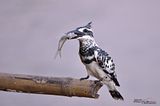Like I said in the earlier post, there were not as many ducks in Oita River as the last winter, and I was disappointed. Seems like this winter is going to be really dull for birding around here. The first snow finally covered Mt. Tsurumi on December 12, and we just had a series of semi-blizzards a few days ago. I just hope that the cold wind will continue to bring in some good migrants, especially the Baikal Teal. On the early morning of December 13, I took a train to Kaku and walked to the area where I found the Baikal Teal last year. No Baikal Teal was found. Instead, I got a decent shot of a male Common Teal (Anas crecca), and many shots of the Little Grebes as you can see in the earlier post.
Full moon setting behind Mt. Tsurumi
Male Common Teal (Anas crecca)



Long-tailed Tit (Aegithalos caudatus trivirgatus)
There were usual stuff along the river, a small flock of 3 Long-tailed Tits (Aegithalos caudatus trivirgatus) feeding near a fruiting tree that looked more like a flowering tree, a few Dusky Thrushes, Oriental Turtle-Doves, Bull-headed Shrikes and Black-faced Buntings. There were not so many birds in the river, except for the Little Grebes which seemed to be everywhere. The number of Common Coot (Fulica atra) seems to be much lower than the last winter, but at least there were still quite many of them swimming in the dam on the upper stream. In contrast, this winter I found Common Coots showing up in different places in Beppu for the first time. I even recently saw one feeding in a small port next to my dorm.


Common Coot (Fulica atra)
A pair of Eurasian Wigeons (Anas penelope)



Female Common Merganser (Mergus merganser)
There were more ducks at the dam, and I also found a female Common Merganser (Mergus merganser) for the first time in this area. After scanning through the flocks of sleeping ducks, I was sad to find nothing special. Most of them were Eurasian Wigeons (Anas penelope), Mallards, Common Teals and Chinese Spot-billed Ducks. All of the ducks seemed to be quite lazy and didn't move even until 11:00AM. The merganser was swimming in the middle of the dam, but even after hour of waiting it still didn't come any closer. The coots and Little Grebes were swimming closer to the bank than most of the ducks though
Eating fresh leave picked up from the surface of water




Male and female Common Teals (Anas crecca)
Male Mallard (Anas platyrhynchos)



Male and female Eurasian Wigeons (Anas penelope)
Unidentified female Wigeon
The above female wigeon got me puzzled. Its head speckles look a bit odd for normal Eurasian Wigeon, so I took photos of it while it was swimming pass my hide. I posted a few photos of it in Bird Forum and few people who made a comment said that it looks like a female American Wigeon (Anas americana) but they can't be definite until they see the bird's axillaries. American Wigeon has white axillaries, while Eurasian has barred axillaries which make them look greyish. There have been a few records of American Wigeons in Oita River by other birders. All of them were, of course, male birds. I wonder how many female American Wigeons have been overlooked each winter.























































.jpg)
